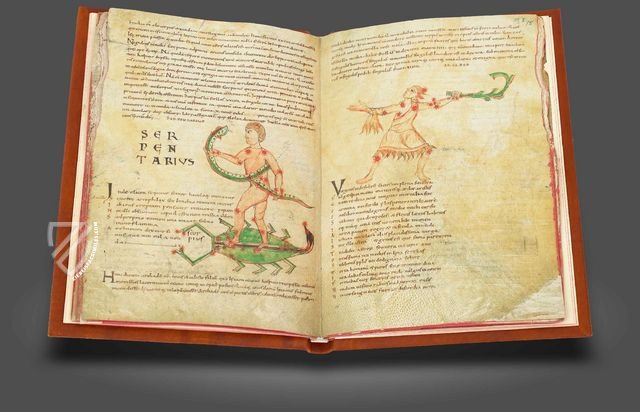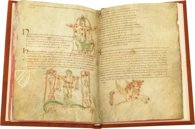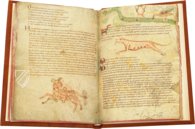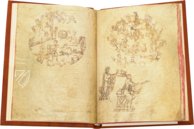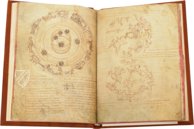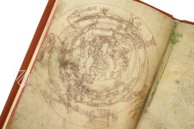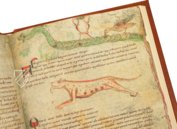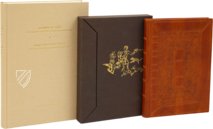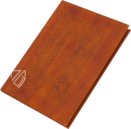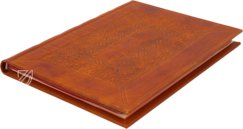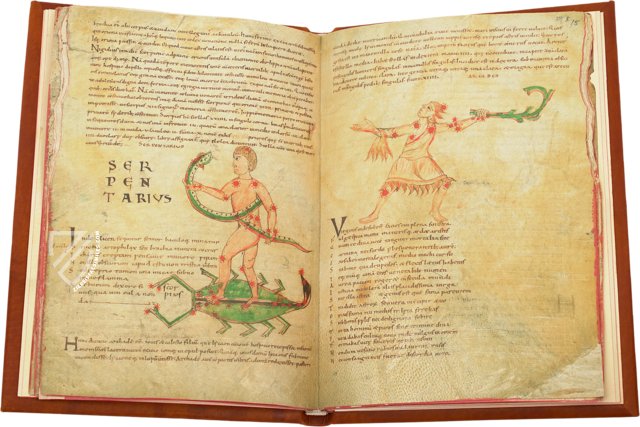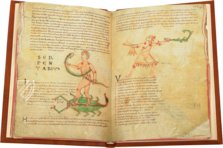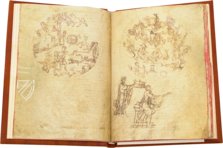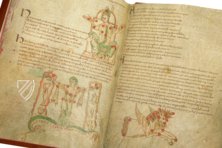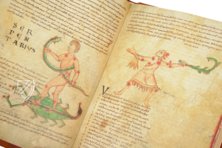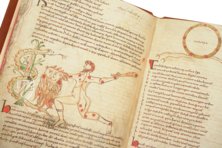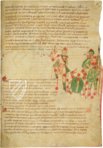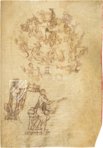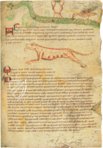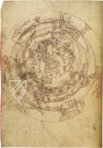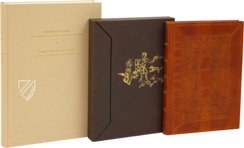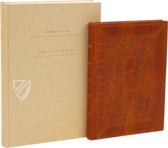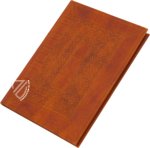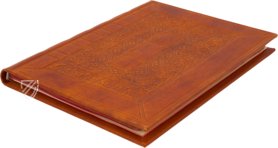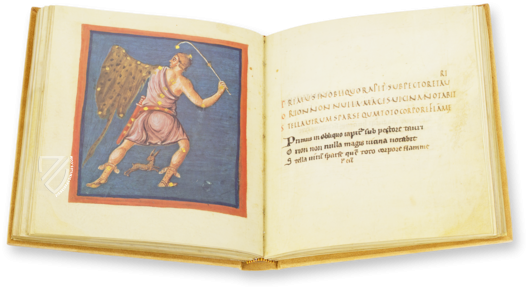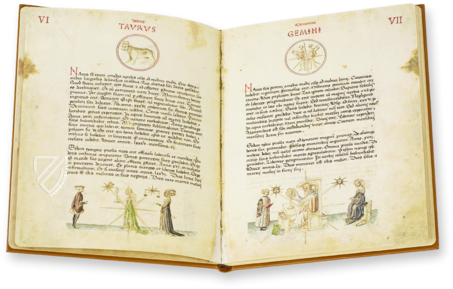Aberystwyth Aratea
(1,000€ - 3,000€)
The post-Carolingian manuscript Constellations from Antiquity was created around the year 1000 in France’s Fleury Abbey, a center of medieval astronomy. This well-preserved transcript of a doctrinal poem by the famous ancient poet Aratus impressively illustrates the collected astronomical knowledge of antiquity: 23 delicately colored pen drawings of the constellations, seven celestial maps, as well as hemispheres, planispheres, and the planetary orbits with the zodiac adorn this historically significant illuminated manuscript.
Constellations from Antiquity
Constellations have been the decisive signpost for sailors, commercial caravans, and travelers for thousands of years. Today, technical innovations have replaced the constellations as navigators for travelers, but the fascination with the constellations that we have encountered every night since humanity's inception continues unabated. From antiquity to the Middle Ages, or at least until the end of the 12th century, all treatises on constellations in Europe went back to the Greek celestial description of the poet Aratus of Soloi (ca. 310–240 BC). As the only source of reference, his work is of inestimable importance and is also the textual basis for the *Constellations from Antiquity.
Aratus – the Ancient Poet of the Stars
Aratus wrote his astronomical didactic poem between 276 and 274 BC at the Macedonian court and gave his poem the title Phainómena, which means "Appearances". Aratus’ work also became known in Rome, where Claudius Germanicus (15 BC – AD 19), a grand-nephew of Emperor Augustus, translated the work into Latin. This translation, the Phaenomena, eventually enshrined the astronomical doctrinal poem into a Christian context. Aratus explained the orbits based on the position of the constellations: the Tropic of Cancer, Tropic of Capricorn, Equator, the zodiac, and finally the Milky Way. In his remarks, the ancient scholar differentiates between fixed and wandering stars and explains his findings on the five planets.
The Introductory Miniature – The Art of the Carolingians in Ancient Tradition
In the introductory miniature (fol. 11v), the poet is set in the midst of his writing a memorial: framed by two Corinthian columns, Aratus debates with his muse Urania concerning the celestial globe standing between them. The group of figures with the poet Aratus and his muse Urania is, except for one other manuscript, unique in the history of art and of inestimable importance. This miniature with folding chair, toga, and the globe stand with lion's feet is exemplary of the classical tradition, as it was praised in the art of the Carolingians.
In the Center for Astronomical Studies: Fleury Abbey
Through his return to the knowledge of antiquity, Charlemagne initiated a systematic renewal of the sciences. In the course of developing the early medieval monastic schools into important scientific centers, the Fleury Abbey in Saint-Benoit-sur-Loire east of Orléans became the most important center for astronomical studies in the 10th and 11th centuries. The abbey established itself through its impressive technical equipment: numerous celestial globes and various devices for the systematic observation of the stars were part of its inventory as well as a huge library, which was housed in a separate multi-story building and represented the heart of Fleury. In this place of accumulated knowledge and scholarship, the manuscript Constellations from Antiquity was copied ca. 1000 from the ancient original and illustrated in rarely seen splendor. Even after more than a thousand years, the impressive craftsmanship with which the text of the Constellations from Antiquity was embellished by spirited and delicately colored pen drawings remains extraordinary. These drawings are not only testimonials to medieval book art, but allow for fascinating insights into the image of the cosmos, which dominated the imagination of astronomers at that time.
The Astronomy Book of the Post-Carolingian Era.
The parchment manuscript, despite its thousand years, is exceptionally well preserved. This historic document received its current leather binding with blind embossing in London in the 17th century and is adorned on the front and back covers with geometric motifs and embossed images. The illuminated manuscript was privately held until 1913 and was then donated to the National Library of Wales in Aberystwyth, where it is kept today under the signature Ms 735C. Since then, it is considered to be the oldest manuscript of the National Library of Wales in Aberystwyth and is guarded as a special treasure. In the face of the technical achievements of our time, in which high performance computers and giant telescopes make the capabilities of a single human seem insignificant, it is all the more astonishing what observations the ancient poet Aratus wrote in his didactic poem, which fascinates the world to this day.
Codicology
- Alternative Titles
- Germanici Caesaris Aratea
Sternbilder der Antike - Size / Format
- 52 pages / 23.5 × 16.5 cm
- Origin
- France
- Date
- 11th century
- Style
- Genre
- Language
- Script
- Carolingian minuscule
- Illustrations
- 23 subtly colored pen and ink drawings of the individual constellations and 7 star charts (hemispheres, planispheres, planetary orbits, and zodiac signs)
- Content
- A didactic poem clarifying the order of the constellations with fantastical drawings
- Artist / School
- At least two monastic illuminators
- Previous Owners
- Thomas Lloyd Fitzhugh
Constellations from Antiquity
Zodiac Circle with Planets
The seven planets of the Solar System that were known to astronomers a thousand years ago are depicted as portraits of human faces spinning in circles labelled in Latin. They are surrounded by the Zodiac symbols that rule over the planets and the mere mortals who live upon them. These playful pen and ink drawings are remarkably naturalistic for the period and created with expressive individual faces, e.g. Virgo is shrugging her shoulders with a sad look on her face.
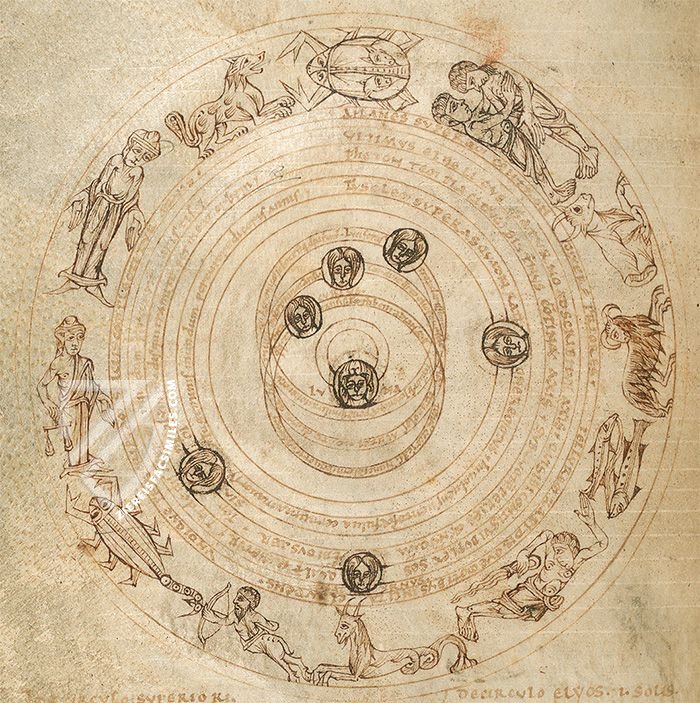
Constellations from Antiquity
Hercules
One of the most beloved figures of ancient mythology, a Christianized version of Hercules continued to be praised during the Middle Ages as an allegorical figure and role model for bravery, wisdom, and morality. Furthermore, his return from the underworld and later ascent to become a constellation was seen as Christ-like.
Aside from the Golden Fleece, the most easily recognizable symbols associated with Hercules are shown here: his gnarled club, the Nemean Lion, and the snake sent by the Goddess Hera to kill him as a baby, which he strangled. Hercules has a piercing look on his face but the lion is depicted as oddly friendly, almost cartoonish, and looks directly at the beholder. Red-orange stars represent the arrangement of his constellation.
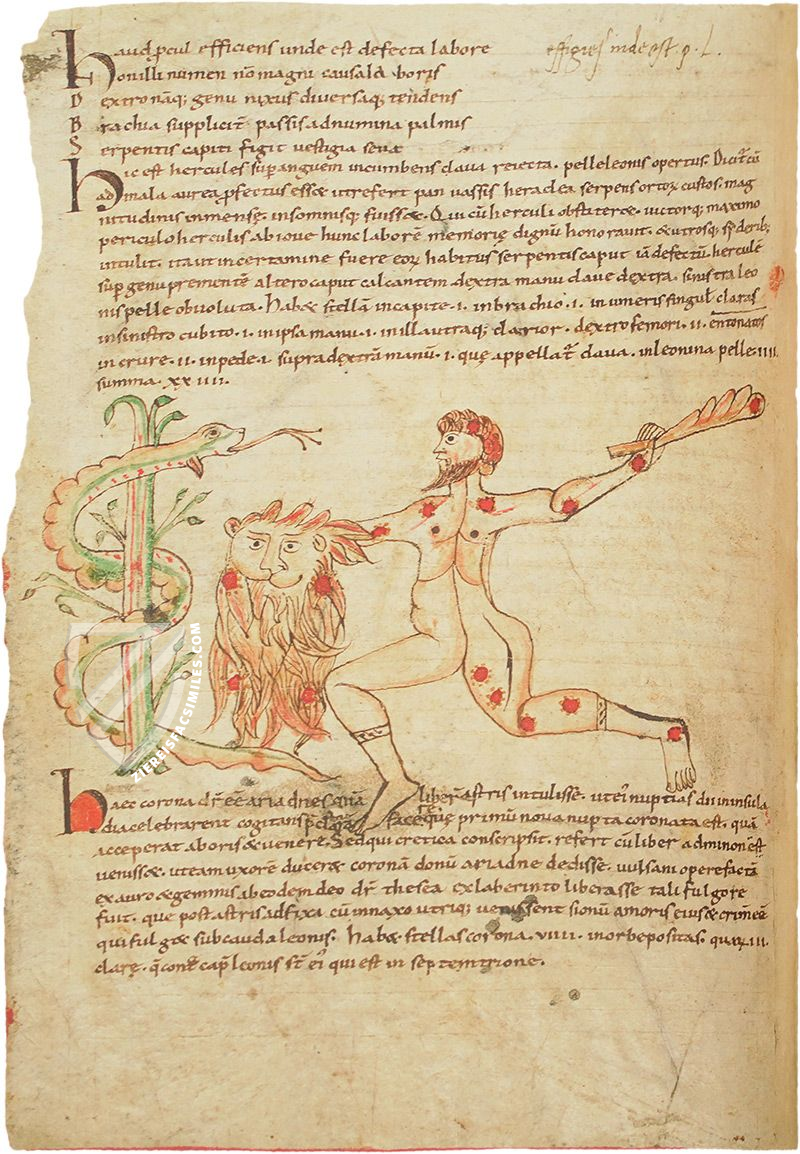
#1 Sternbilder der Antike
Languages: German and English
(1,000€ - 3,000€)
- Treatises / Secular Books
- Apocalypses / Beatus
- Astronomy / Astrology
- Bestiaries
- Bibles / Gospels
- Chronicles / History / Law
- Geography / Maps
- Saints' Lives
- Islam / Oriental
- Judaism / Hebrew
- Single Leaf Collections
- Leonardo da Vinci
- Literature / Poetry
- Liturgical Manuscripts
- Medicine / Botany / Alchemy
- Music
- Mythology / Prophecies
- Psalters
- Other Religious Books
- Games / Hunting
- Private Devotion Books
- Other Genres
- Afghanistan
- Armenia
- Austria
- Belgium
- Colombia
- Croatia
- Cyprus
- Czech Republic
- Denmark
- Egypt
- Ethiopia
- France
- Germany
- Greece
- Hungary
- India
- Iran
- Iraq
- Israel
- Italy
- Japan
- Lebanon
- Luxembourg
- Mexico
- Morocco
- Netherlands
- Palestine
- Peru
- Poland
- Portugal
- Russia
- Serbia
- Spain
- Sri Lanka
- Sweden
- Switzerland
- Syria
- Turkey
- Ukraine
- United Kingdom
- United States
- Uzbekistan
- Aboca Museum
- Ajuntament de Valencia
- Akademie Verlag
- Akademische Druck- u. Verlagsanstalt (ADEVA)
- Aldo Ausilio Editore - Bottega d’Erasmo
- Alecto Historical Editions
- Alkuin Verlag
- Almqvist & Wiksell
- Amilcare Pizzi
- Andreas & Andreas Verlagsbuchhandlung
- Archa 90
- Archiv Verlag
- Archivi Edizioni
- Arnold Verlag
- ARS
- Ars Magna
- ArtCodex
- AyN Ediciones
- Azimuth Editions
- Badenia Verlag
- Bärenreiter-Verlag
- Belser Verlag
- Belser Verlag / WK Wertkontor
- Benziger Verlag
- Bernardinum Wydawnictwo
- BiblioGemma
- Biblioteca Apostolica Vaticana (Vaticanstadt, Vaticanstadt)
- Bibliotheca Palatina Faksimile Verlag
- Bibliotheca Rara
- Boydell & Brewer
- Bramante Edizioni
- Bredius Genootschap
- Brepols Publishers
- British Library
- C. Weckesser
- Caixa Catalunya
- Canesi
- CAPSA, Ars Scriptoria
- Caratzas Brothers, Publishers
- Carus Verlag
- Casamassima Libri
- Chavane Verlag
- Christian Brandstätter Verlag
- Circulo Cientifico
- Club Bibliófilo Versol
- Club du Livre
- CM Editores
- Collegium Graphicum
- Collezione Apocrifa Da Vinci
- Comissão Nacional para as Comemorações dos Descobrimentos Portugueses
- Coron Verlag
- Corvina
- CTHS
- D. S. Brewer
- Damon
- De Agostini/UTET
- De Nederlandsche Boekhandel
- De Schutter
- Deuschle & Stemmle
- Deutscher Verlag für Kunstwissenschaft
- DIAMM
- Droz
- E. Schreiber Graphische Kunstanstalten
- Ediciones Boreal
- Ediciones Grial
- Ediclube
- Edições Inapa
- Edilan
- Editalia
- Edition Deuschle
- Edition Georg Popp
- Edition Leipzig
- Edition Libri Illustri
- Editiones Reales Sitios S. L.
- Éditions de l'Oiseau Lyre
- Editions Medicina Rara
- Editorial Casariego
- Editorial Mintzoa
- Editrice Antenore
- Editrice Velar
- Edizioni Edison
- Egeria, S.L.
- Eikon Editores
- Electa
- Emery Walker Limited
- Enciclopèdia Catalana
- Eos-Verlag
- Ephesus Publishing
- Ernst Battenberg
- Eugrammia Press
- Extraordinary Editions
- Fackelverlag
- Facsimila Art & Edition
- Facsimile Editions Ltd.
- Facsimilia Art & Edition Ebert KG
- Faksimile Verlag
- Feuermann Verlag
- Folger Shakespeare Library
- Franco Cosimo Panini Editore
- Friedrich Wittig Verlag
- Fundación Hullera Vasco-Leonesa
- G. Braziller
- Gabriele Mazzotta Editore
- Gebr. Mann Verlag
- Gesellschaft für graphische Industrie
- Getty Research Institute
- Giovanni Domenico de Rossi
- Giunti Editore
- Graffiti
- Grafica European Center of Fine Arts
- Guido Pressler
- Guillermo Blazquez
- Gustav Kiepenheuer
- H. N. Abrams
- Harrassowitz
- Helikon
- Hendrickson Publishers
- Henning Oppermann
- Herder Verlag
- Hes & De Graaf Publishers
- Hoepli
- Holbein-Verlag
- Hortus Deliciarum
- Houghton Library
- Hugo Schmidt Verlag
- Idion Verlag
- Il Bulino, edizioni d'arte
- ILte
- Imago
- Insel Verlag
- Instituto Nacional de Antropología e Historia
- Istituto dell'Enciclopedia Italiana - Treccani
- Istituto Ellenico di Studi Bizantini e Postbizantini
- Istituto Geografico De Agostini
- Istituto Poligrafico e Zecca dello Stato
- Italarte Art Establishments
- J. Thorbecke
- Jan Thorbecke Verlag
- Johnson Reprint Corporation
- Josef Stocker
- Josef Stocker-Schmid
- Jugoslavija
- Karl W. Hiersemann
- Kasper Straube
- Kaydeda Ediciones
- Kindler Verlag / Coron Verlag
- Kodansha International Ltd.
- Konrad Kölbl Verlag
- Kurt Wolff Verlag
- La Liberia dello Stato
- La Linea Editrice
- La Meta Editore
- Lambert Schneider
- Landeskreditbank Baden-Württemberg
- Leo S. Olschki
- Les Incunables
- Library of Congress
- Libreria Musicale Italiana
- Lichtdruck
- Lito Immagine Editore
- Lumen Artis
- Lund Humphries
- M. Moleiro Editor
- Maison des Sciences de l'homme et de la société de Poitiers
- Manuscriptum
- Martinus Nijhoff
- Maruzen-Yushodo Co. Ltd.
- MASA
- McGraw-Hill
- Militos
- Millennium Liber
- Müller & Schindler
- Nahar and Steimatzky
- National Library of Wales
- Neri Pozza
- Nova Charta
- Oceanum Verlag
- Odeon
- Orbis Mediaevalis
- Orbis Pictus
- Österreichische Staatsdruckerei
- Oxford University Press
- Pageant Books
- Parzellers Buchverlag
- Patrimonio Ediciones
- Pattloch Verlag
- PIAF
- Pieper Verlag
- Plon-Nourrit et cie
- Prestel Verlag
- Princeton University Press
- Prisma Verlag
- Priuli & Verlucca, editori
- Pro Sport Verlag
- Propyläen Verlag
- Pytheas Books
- Quaternio Verlag Luzern
- Reales Sitios
- Recht-Verlag
- Reichert Verlag
- Reichsdruckerei
- Riehn & Reusch
- Roberto Vattori Editore
- Rosenkilde and Bagger
- Roxburghe Club
- Salerno Editrice
- Sarajevo Svjetlost
- Schöck ArtPrint Kft.
- Scolar Press
- Scrinium
- Scripta Maneant
- Scriptorium
- Siloé, arte y bibliofilia
- SISMEL - Edizioni del Galluzzo
- Sociedad Mexicana de Antropología
- Société des Bibliophiles & Iconophiles de Belgique
- Soncin Publishing
- Sorli Ediciones
- Stainer and Bell
- Studer
- Styria Verlag
- Sumptibus Pragopress
- Szegedi Tudomànyegyetem
- Taberna Libraria
- Tarshish Books
- Taschen
- Tempus Libri
- Testimonio Compañía Editorial
- Thames and Hudson
- The Clear Vue Publishing Partnership Limited
- The Facsimile Codex
- The Folio Society
- The Marquess of Normanby
- The Richard III and Yorkist History Trust
- Tip.Le.Co
- TouchArt
- TREC Publishing House
- TRI Publishing Co.
- Trident Editore
- Typis Regiae Officinae Polygraphicae
- Union Verlag Berlin
- Universidad de Granada
- University of California Press
- University of Chicago Press
- Urs Graf
- Vallecchi
- Van Wijnen
- VCH, Acta Humaniora
- VDI Verlag
- VEB Deutscher Verlag für Musik
- Verlag Anton Pustet / Andreas Verlag
- Verlag Bibliophile Drucke Josef Stocker
- Verlag der Münchner Drucke
- Verlag für Regionalgeschichte
- Verlag Styria
- Vicent Garcia Editores
- W. Turnowsky
- Waanders Printers
- Wiener Mechitharisten-Congregation (Wien, Österreich)
- Wissenschaftliche Buchgesellschaft
- Wydawnictwo Dolnoslaskie
- Xuntanza Editorial
- Zakład Narodowy
- Zollikofer AG

